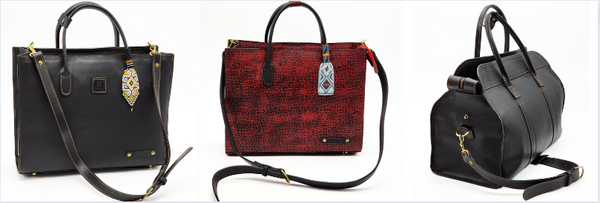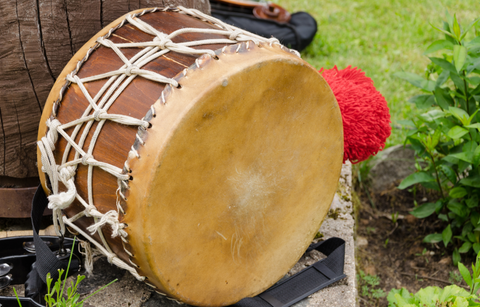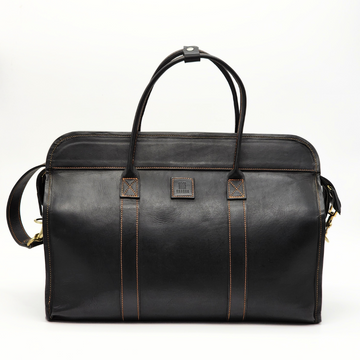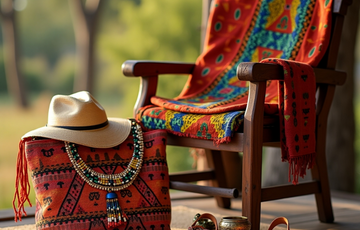African leather, renowned for its resilience, versatility, and unique allure, holds a treasured place in the annals of history. For centuries, the continent's rich and diverse cultures have woven a tapestry of leatherworking traditions, showcasing the remarkable craftsmanship and creativity of its people.
The Rich Tapestry of Leather Crafting History
Leather crafting has been an integral part of African culture for millennia. Ancient civilizations, such as Egypt, adorned their pharaohs and elite with intricate leather garments and footwear, marking the earliest records of leatherworking in Africa. As time passed, the craft expanded across the continent, each region infusing its distinct styles and techniques into the art form.

image of an ancient pharaoh and wife in leather attire.
A Spectrum of Leather Types
In Africa, an abundance of animal hides and skins serves as the foundation for exquisite leather creations. Cowhide, sheepskin, goat leather, and even the esteemed crocodile skin are among the many materials employed. Each type of leather boasts its own distinctive qualities, such as texture, thickness, and color. Cowhide, recognized for its remarkable durability and strength, stands in stark contrast to the supple softness of sheepskin. Ostrich leather, with its captivating quill pattern and enduring resilience, captures the imagination of leather enthusiasts worldwide.

collage image of different types of leather
Mastering the Art of Leather Crafting
The art of leather crafting in Africa involves a meticulous and intricate process, encompassing a series of precise steps. From the careful selection of hides and skins to the final touches, the journey to a finished product is a testament to the artisans' expertise. After cleansing and treating the hides, they are skillfully cut into desired shapes and sizes, guided by patterns or templates. The leather is then diligently punched, sewn, or intricately glued together, tailored to suit the intended item. The final transformation occurs through the application of oils, dyes, and other treatments, culminating in a polished and refined surface.

Leather with tools used for the production process.
Contemporary Marvels of African Leather Craftsmanship
Today, the legacy of African leather crafting thrives, manifesting in a myriad of exquisite creations. Footwear, bags, wallets, belts, and an array of accessories showcase the breadth of artisanal ingenuity. These meticulously crafted pieces capture the essence of African aesthetics while embracing modern trends. Leather goods from Africa combine style, durability, and functionality, offering an unrivaled fusion of artistry and practicality.

Collage of leather products all from Mawu Marketplace.
Versatility and Timelessness in Modern Applications
African leather products embody more than just aesthetic beauty; they are beloved for their exceptional durability and versatility. These masterpieces of craftsmanship seamlessly transition from everyday use to special occasions. A leather handbag becomes a trusted companion, accompanying its owner on adventures, while leather wallets and card holders merge elegance with functionality, safeguarding essentials with timeless sophistication.
Beyond their utilitarian purpose, African leather products resonate with cultural significance. In many African societies, leather items remain woven into traditional attire, symbolizing status and community roles. Additionally, these distinctive creations often find themselves as cherished gifts or central elements in ceremonial events, perpetuating age-old customs and heritage.

An African Drum Made of Leather and Wood.
Embracing Sustainability: The Evolution of African Leather Working
African leather artisans are increasingly embracing sustainable practices in their craft, recognizing the importance of preserving the environment and traditional techniques. They prioritize working with ethically sourced animal hides and skins, ensuring the humane treatment of animals. Additionally, the adoption of eco-friendly tanning methods, such as vegetable tanning, reduces the environmental impact associated with chemical-based processes. Artisans also demonstrate resourcefulness by recycling and repurposing leather offcuts and scraps, minimizing waste and maximizing the utility of each piece. Through these sustainable practices, African leather working promotes ethical standards, preserves natural resources, and ensures the longevity of the craft while showcasing the harmonious blend of beauty, craftsmanship, and environmental consciousness.

Leather made purses placed on top of a flower bed.
Discover our leather collection






